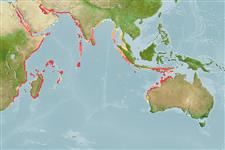Klassifizierung / Names
Namen | Synonyme | Catalog of Fishes(Gattung, Arten) | ITIS | CoL | WoRMS | Cloffa
>
Blenniiformes (Blennies) >
Tripterygiidae (Triplefin blennies) > Tripterygiinae
Etymology: Enneapterygius: Greek, ennea = nine times + Greek, pterygion = little fin (Ref. 45335).
Environment: milieu / climate zone / depth range / distribution range
Ökologie
seewasser demersal. Tropical
Western Indian Ocean: Red Sea, east coast of Africa to northern KwaZulu-Natal.
Size / Gewicht / Alter
Maturity: Lm ? range ? - ? cm
Max length : 2.7 cm SL Männchen/unbestimmt; (Ref. 88983)
Kurzbeschreibung
Morphologie | Morphometrie
Rückenflossenstacheln (insgesamt): 14 - 15; Rückenflossenweichstrahlen (insgesamt): 8-10; Afterflossenstacheln 1; Afterflossenweichstrahlen: 16 - 17; Wirbelzahl: 32 - 33. This species is distinguished by the following characters: D III + XI-XIII + 8-10 (usually III + XII + 9); A I, 16-17 (usually 16 rays); pectoral fin 15: usually 2+6+7; lateral line, pored scales 11-12, notched scales 20-22 (usually 22), notched segment starting next scale row below end of pored segment; total lateral scales 29-30; dentary pores 3 + 2 + 3 ; head length 3.3-3.9 and body depth 4.4-5.2 in SL; eye 2.8-3.6 in HL; nape scaled; belly with thin cycloid scales; a row of cycloid scales on pectoral fin base, parallel with margin of branchiostegal membrane; supratemporal sensory canal crescent-shaped; orbital cirrus length about half of pupil diameter and either rounded or divided; upper and posterior margins of orbits with fine serrations; first dorsal fin equal in height to second in females, about 10% higher in males; pelvic-fin rays are united for less than half their length, the longest ray reaching almost to vent; mouth slightly down-turned and reaches vertical through anterior of pupil; diagonal brown bars across body with reddish dorsal and caudal fins (Ref. 88983).
This species is uncommon (Ref. 57774) and very secretive. Adults live in sheltered lagoons with many nooks and crannies, in close association with hard corals (Ref. 88983). Eggs are hemispherical and covered with numerous sticky threads that anchor them in the algae on the nesting sites (Ref. 240). Larvae are planktonic which occur primarily in shallow, nearshore waters (Ref. 94114).
Life cycle and mating behavior
Geschlechtsreife | Fortpflanzung | Ablaichen | Eier | Fecundity | Larven
Holleman, W. and S.V. Bogorodsky, 2012. A review of the blennioid fish family Tripterygiidae (Perciformes) in the Red Sea, with description of Enneapterygius qirmiz, and reinstatement of Enneapterygius altipinnis Clark, 1980. Zootaxa 3152:36-60. (Ref. 88983)
IUCN Rote Liste Status (Ref. 130435)
Bedrohung für Menschen
Harmless
Nutzung durch Menschen
Mehr Information
NamenSynonymeMetabolismusRäuberÖkotoxikologieFortpflanzungGeschlechtsreifeAblaichenSpawning aggregationFecundityEierEientwicklung
ReferenzenAquakulturAquakultur ProfilZuchtlinienGenetikElectrophoresesVererbbarkeitKrankheitenVerarbeitungNutrientsMass conversion
PartnerBilderStamps, Coins Misc.LauteCiguateraGeschwindigkeitSchwimmstilKiemenoberflächeOtolithsGehirngrößeSehfähigkeit
Tools
Zusatzinformationen
Download XML
Internet Quellen
Estimates based on models
Preferred temperature (Ref.
123201): 24.8 - 29, mean 27.5 °C (based on 730 cells).
Phylogenetic diversity index (Ref.
82804): PD
50 = 0.5000 [Uniqueness, from 0.5 = low to 2.0 = high].
Bayesian length-weight: a=0.00562 (0.00258 - 0.01228), b=3.08 (2.89 - 3.27), in cm total length, based on LWR estimates for this (Sub)family-body shape (Ref.
93245).
Trophic level (Ref.
69278): 3.1 ±0.3 se; based on size and trophs of closest relatives
Widerstandsfähigkeit (Ref.
120179): hoch, Verdopplung der Population dauert weniger als 15 Monate. (Preliminary K or Fecundity.).
Fishing Vulnerability (Ref.
59153): Low vulnerability (10 of 100).
